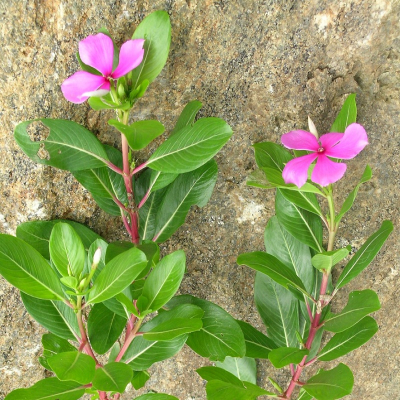Catharanthus roseus (Linn.) G.Don
Synonyms : Vinca rosea Linn.
Family : Apocynaceae
Group : Anti hypertensive
Parts Used : Whole plant
Vernacular Names :-
| English | : | Periwinkle |
| Malayalam | : | Ushamalari, Savakottappacha |
| Hindi | : | Sudabahar |
| Sanskrit | : | Nityakalyani |
| Bengali | : | Rattanjot |
| Kannada | : | Nityamallige |
| Tamil | : | Sudukattumallikai |
| Telungu | : | Billaganeru |
Distribution and Habitat: The plant is a native of Madagascar and hence the name Madagascar periwinkle. It is distributed in West Indies, Mozambique, South Vietnam, Sri Lanka, Philippines and Australia. It is well adapted to diverse agroclimatic situations prevalent in India and is commercially cultivated in the states of Tamil Nadu, Karnataka, Gujarat, Madhya Pradesh and Assam.
Botany: Periwinkle or Vinca is an erect handsome herbaceous perennial plant which is a chief source of patented cancer and hypotensive drugs. It grows upto 75 cm high.
- Leaves: Elliptic –ovate to oblong, glabrous to puberulous, base acute or cuneate, apex obtusely apiculate, lateral nerves 10-12 pairs, petiole 1-1.5 cm.
- Flowers: In axillary or terminal cymes; solitary or paired, shortly pedicellate, pink or white or white with pink or yellow ring in orifice region; mericarps 3-4 x 0.3 cm, puberulous.
- Fruits: Pairs of follicles.
Properties: The different alkaloids present in Catharanthus roseus possess anticancerous, antidiabetic, diuretic, antihypertensive, antimicrobial, antidysentric, haemorrhagic, antifibrillic, tonic, stomachic, sedative and tranquillizing activities.
Chemical constituents: More than 100 alkaloids and related compounds have so far been isolated and characterised from this plant. These alkaloids includes monomeric indole alkaloids, 2-acyl indoles, oxindole, α-methylene indolines, dihydroindoles, bisindole and others. Dry leaves contain vinblastine and vincristine which have anticancerous activity. Other alkaloids reported are vincoside, isovincoside (strictosidine), catharanthine, vindolinine, lochrovicine, vincolidine, ajmalicine (raubasine), reserpine, serpentine, leurosine, lochnerine, tetrahydroalstonine, vindoline, pericalline, perivine, periformyline, perividine, carosine, leurosivine, leurosidine and rovidine.
Uses: It is known for use in the treatment of diabetes in Jamaica and India. It is useful in the treatment of choriocarcinoma and Hodgkin's disease-a cancer affecting lymph glands, spleen and liver. Its leaves are used for curing diabetes, menorrhagia and wasp stings. Root is tonic, stomachic, hypotensive, sedative and tranquilliser. USA, Hungary, West Germany, Italy, Netherlands and UK are the major consumers.
Agrotechnology
Soil and climate: It can grow on any type of soil, except those which are highly saline, alkaline or waterlogged. Light soils, rich in humus are preferable for large scale cultivation since harvesting of the roots become easy. Periwinkle grows well under tropical and subtropical climate. A well distributed rainfall of 1000 mm or more is ideal. In north India the low winter temperatures adversely affect the crop growth.
Propagation: Catharanthus is propagated by seeds. Fresh seeds should be used since they are short-viable. Seeds can be either sown directly in the field or sown in a nursery and then transplanted. Seed rate is 2.5 kg/ ha for direct sowing and the seeds are drilled in rows 45 cm apart or broadcasted. For transplanted crop, the seed rate is 500g/ ha. Seeds are sown in nursery and transplanted at 45 x 30 cm spacing after 60 days when the seedlings attain a height of 15-20 cm. Nursery is prepared two months in advance so that transplanting coincides with the on set of monsoons.
Manuring: Application of FYM at the rate of 15 t/ ha is recommended. An alternate approach is to grow leguminous green manure crops and incorporate the same into the soil at flowering stage. Fertilisers are recommended at 80:40:40 kg N: P2O5: K2O/ ha for irrigated crop and 60:30:30 kg/ha for rainfed crop. N is applied in three equal splits, at planting, at 45 and 90 days after planting.
Irrigation: 4 or 5 irrigations will be needed to optimise yield when rainfall is restricted. Fortnightly irrigations support good crop growth when the crop is grown exclusively as an irrigated crop.
After cultivation: Weeding is carried out before each top dressing. Alternatively, use of fluchloraline at 0.75 kg a.i./ ha as pre-plant or alachlor at 1.0 kg a.i./ ha as pre-emergence herbicide provides effective control of a wide range of weeds in periwinkle crop.
Plant protection: No major pests, other than oleander hawk moth, have been reported in this crop. Fungal diseases like twig blight (top rot or dieback ) caused by Phytophthora nicotianae, Pythium debaryanum, P. butleri and P. aphanidermatum; leaf spot due to Alternaria tenuissima, A. alternata, Rhizoctonia solani and Ophiobolus catharanthicola and foot-rot and wilt by Sclerotium rolfsii and Fusarium solani have been reported. However, the damage to the crop is not very serious. Three virus diseases causing different types of mosaic symptoms and a phyllody or little leaf disease due to mycoplasma-like organisms have also been reported; the spread of which could be checked by uprooting and destroying the affected plants.
Harvesting: Detopping of plants by 2 cm at 50% flowering stage improves root yield and alkaloid contents. The crop allows 3-4 clippings of foliage beginning from 6 months. The flowering stage is ideal for collection of roots with high alkaloid content. The crop is cut about 7 cm above the ground and dried for stem, leaf and seed. The field is irrigated, ploughed and roots are collected. The average yields of leaf, stem and root are 3.6, 1.5 and 1.5 t/ha, respectively under irrigated conditions and 2.0, 1.0 and 0.75t/ ha, respectively under rainfed conditions on air dry basis. The harvested stem and roots loose 80% and 70% of their weight, respectively. The crop comes up well as an undercrop in eucalyptus plantation in north India. In north western India, a two year crop sequence of periwinkle-senna-mustard or periwinkle-senna- coriander are recommended for higher net returns and productivity.

